In August last year, on what was a very wet and windy day, I drove for an hour and a half to meet a lady I had been desperate to see for about 25 years. I was blown away when I first saw her photograph all those years ago, and in the flesh, she did not disappoint.
Sarah Hare was born in 1689 in Stow Bardolph, a small, blink-and-you’ll-miss-it village in Norfolk, situated between Downham Market and King’s Lynn. The village is centred around the site of Stow Hall: there have been at least three, perhaps four, houses on this site since the land was acquired by Sir Nicholas Hare in 1553. Unfortunately these days a visit to Stow Hall is not possible, as the last house, built in 1874, was demolished one brick at a time in the mid 1990s, after it fell into disrepair following many years of neglect. However the gardens still remain, and are well worth a visit should you ever find yourself in this part of the world.
But it is the first house we are interested in – an attractive, red brick mansion, built in 1589 – for it was here that Sarah lived, the youngest daughter of Sir Thomas Hare. The family into which she was born were influential and prosperous, and played an important part in the history of Stow Bardolph. The Hares were lords of the manor for four hundred years, and lived there through 17 reigns. Look around on a visit and you’ll see frequent reminders of the family’s importance dotted about, including The Hare Arms pub, and the Hare Chapel, which was added to the church by the Hare family in the late sixteenth century.
There is nothing much to mark out Sarah’s life as being anything other than normal and ordinary, but in death she certainly made sure that her name would be remembered in the history books. She died on 9th April 1744, aged around 55, after pricking her finger with a needle while sewing, and succumbing to blood poisoning a few days later. It was said that she was sewing on a Sunday, an incredibly sacrilegious thing to be doing in the mid-eighteenth century, and died as a result.

I travelled to Stow Bardolph with my family in the car, and as they weren’t particularly interested in my little jaunt, I knew that I only had a brief amount of time to tiptoe through the tombstones and track Sarah down. I wish I’d had longer to explore the church and graveyard. A very brief scan of the tombstones and graves there made me think that it would be well worth a second visit, and I will definitely be making a return trip one day. My main concern was that I might be met by a locked door, as it turns out that although the internet knows many things, it struggles with the opening times of a church in rural East Anglia. Luckily, it was open!
Holy Trinity Church, Stow Bardolph
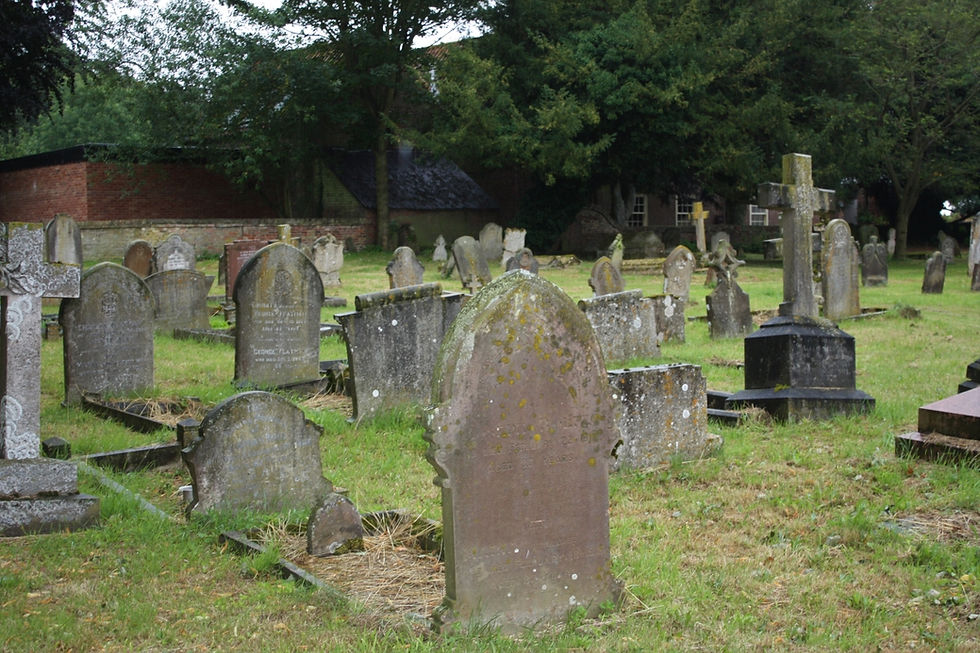
Over the years I have visited countless old buildings, from churches to castles, follies, stately homes and even crypts: I’ve been all over the place with my history hat on. In my experience, most places have an atmosphere or make you feel a certain way. But Holy Trinity was definitely one of the most atmospheric buildings I have ever visited. As I’ve already said the weather was less than desirable, with rain and a slate grey sky outside, which made the interior of the church feel incredibly gloomy and dark. This, along with the fact that I was the only person in there, just added to the tingle factor.
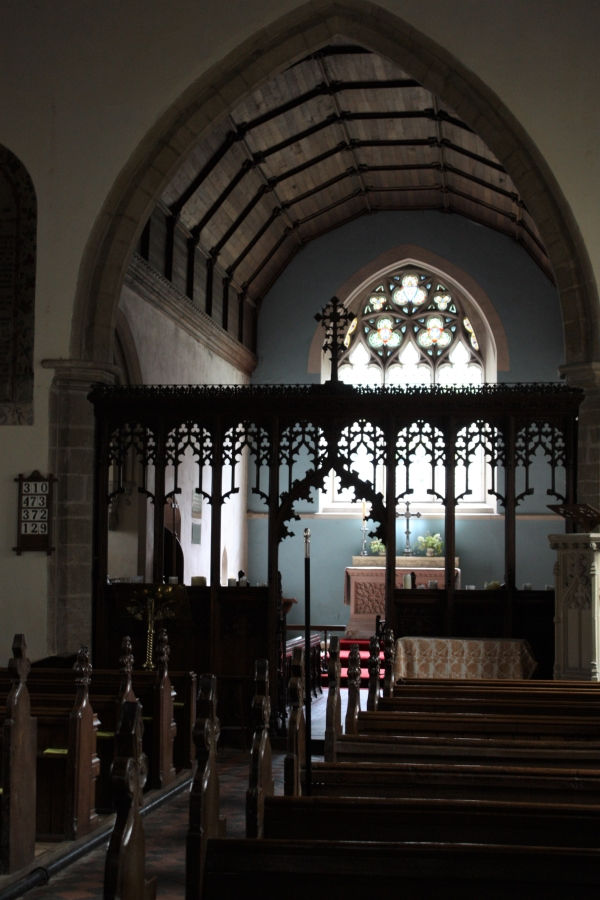
Inside Holy Trinity, in all its gloomy glory
Holy Trinity is a medieval church, with some remaining 12th and 13th century elements, although the nave and chancel were virtually rebuilt during a mid 19th century restoration. It is an interesting church, but interesting churches can be found in more or less every village and town up and down the country. The thing that sets this church apart can be found in a cabinet, in the Hare Chapel.
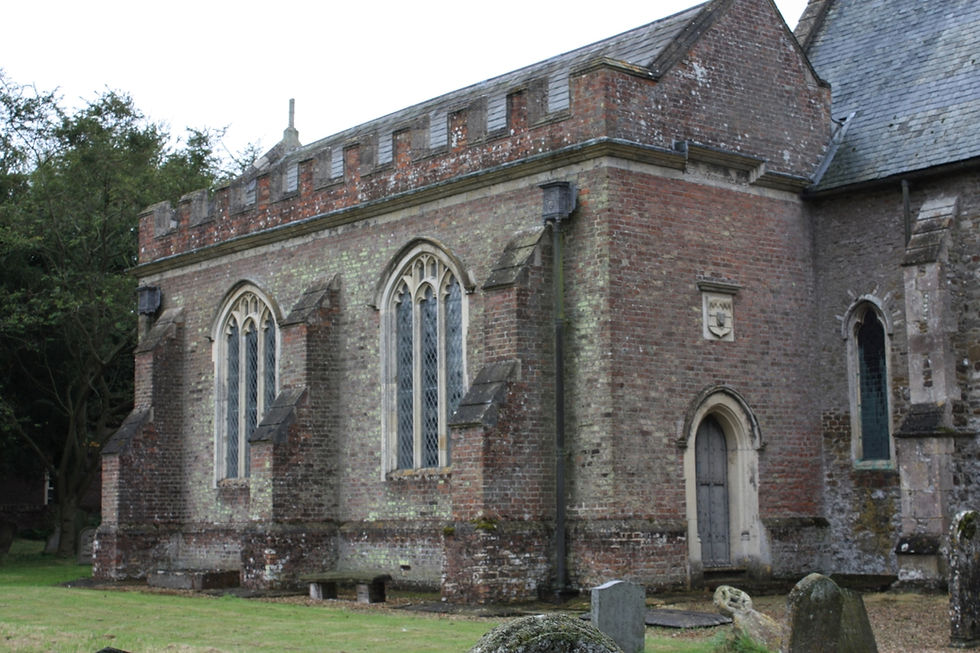
The Hare Chapel
The Hare Chapel, which is actually bigger than the chancel of the church, contains many interesting monuments to members of the esteemed family, and it would be well worth spending some time there to read them all. As it was, time was of the essence and it was Sarah I had come to see, so I took photographs of some of the more interesting looking plaques to read later, and peered around in the gloom for Sarah’s cabinet.
Inside the Hare Chapel, which is packed with memorials to the Hare family, and Sarah's cabinet tucked away in the corner
Most effigies are carved out of marble or engraved on brass, but the wax figure of Sarah Hare sits in a mahogany case, dressed in the clothes which she herself requested before her death. This effigy is the only one of its kind to be found outside of Westminster Abbey.
Funeral effigies are fascinating things, providing as they do the opportunity to meet someone, long dead, and look them in the eye. Westminster Abbey is home to a collection of important funeral effigies, the earliest of which is Edward III, who died of a stroke in 1377. His effigy, a plaster mask on a wooden base, even shows a slight droop to one corner of his mouth, the result of the stroke. These figures were made to display at the funerals of monarchs: the elaborate ceremonies could last for weeks or even months after death, meaning that displaying the body on a bier was decidedly impractical. This custom was also later adopted by aristocrats who commissioned flattering and expensive effigies during their lifetimes, which were displayed as ‘mourners’ during royal ceremonies. Perhaps Sarah had some knowledge of this practice: although unlikely, it is not beyond the realms of possibility that she would have heard about this tradition or even seen some of the figures. However, if you had the monetary means to commission an effigy of yourself in times gone by, human nature would suggest that you might want to be preserved in wax looking your most attractive, even if that meant fudging the truth a little. One word that could not be used to describe Sarah in her unflattering waxy form is attractive: there was no ego massaging going on with the creation of this effigy.
Old photographs of some of the Westminster Abbey effigies, before they were rejuvenated and displayed in the Queen's Diamond Jubilee Galleries.
From left to right: Elizabeth of York (1466-1503), wife of Henry VII; Frances Teresa Stewart, Duchess of Richmond and Lennox (1647-1702), a prominent member of the Court of the Restoration and famous for refusing to become a mistress of Charles II; and Elizabeth I (1533-1603). The original coloured wooden figure was remade in 1760 with a wax head and new outer clothes. (Source: Flickr)
There are 21 funeral effigies to be seen in the Queen’s Diamond Jubilee Galleries at Westminster Abbey, including those of Charles II, Viscount Horatio Nelson, Queen Anne, and members of great aristocratic families. Once known as ‘the ragged regiment’, these figures have recently been given a bit of a spruce up and are displayed in all their finery. Earlier monarchs, including Mary I, lie in glass cases gazing upwards, their bodies made of wood with jointed limbs for when they were placed sitting up on the coffin for the funeral procession, wearing full robes of state and holding the orb and sceptre.
But back to Sarah. Believe me when I say that nothing can really prepare you for the rush you feel when you open that cabinet door. The photographs are undoubtedly intriguing, but they do not really convey what it’s like to meet her in the flesh, or the wax. As you swing open the door of her mahogany cabinet, you are immediately transported back to the mid-eighteenth century as you come face to face with a ghost. I felt as though at any moment she might look at me and start speaking, perhaps to ask me what I was staring at. My hands were shaking as I took the pictures, it was an electrifying experience. I am aware of how dramatic that may sound, and to anyone who is not all that interested in history I do understand that you will struggle to comprehend what on earth I am talking about. But for those of us who spend a great deal of our lives living in and thinking about the past, and would love nothing more than to hop in a time machine and travel back in time (minus the horrible diseases), I’d say that coming face to face with Sarah is about as close as it gets.
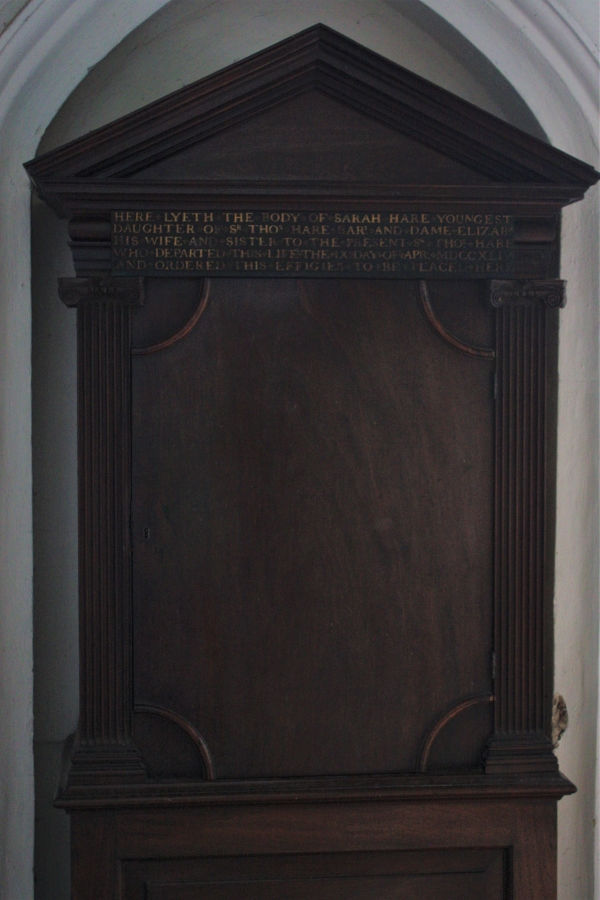
Sarah Hare's cabinet. Not the best photograph, but it hopefully underlines how dark and gloomy it was in the chapel that day!
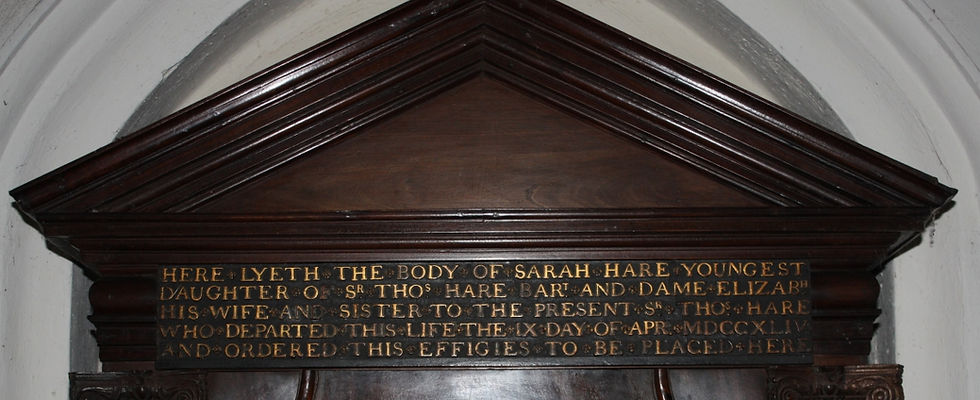
The year before she died, Sarah wrote in her will: “I desire to have my face and hands made in wax with a piece of crimson satin thrown like a garment in a picture hair upon my head and put in a case of Mahogany with a glass before and fix’d up so near the place were my corps lyes as it can be with my name and time of Death put upon the case in any manner most desirable if I do not execute this in my life I desire it may be done after my Death.” Her wishes were carried out to the letter. The dress the figure is wearing belonged to Sarah, as did the wig, which is made from real human hair. The wig was around two decades out of fashion when Sarah died, which was not unusual at the time, as country ladies were often a little behind the times in the fashion stakes compared to their counterparts in the cities. It is not known if her face is taken from a death mask or modelled from life, but reportedly it was a very good likeness, with the moles on her cheeks intact.
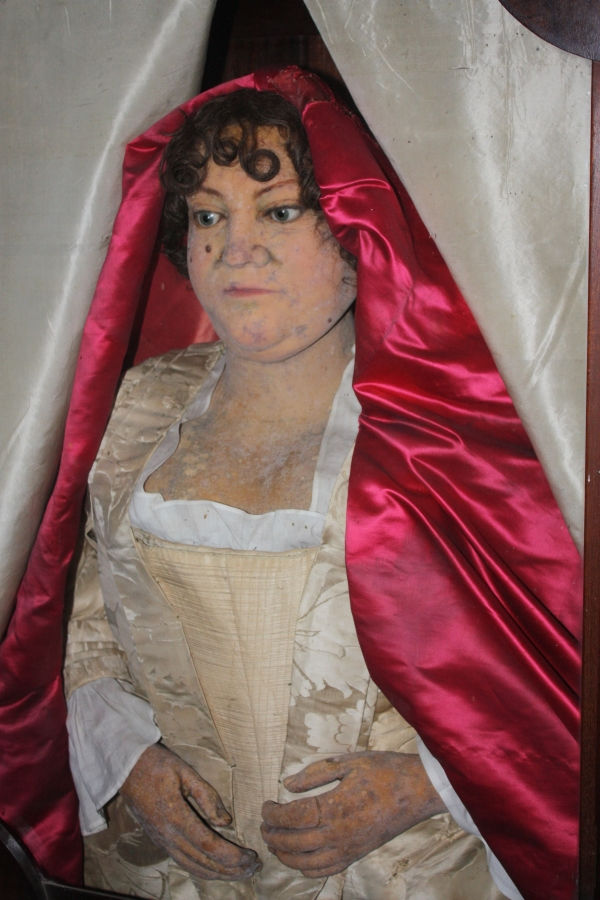
Sarah Hare
Adding to the eeriness of meeting Sarah is the general ‘look’ of her. Some restoration work was carried out on the figure and cabinet in the 1980s, but time takes its toll on the best of us, and Sarah’s skin now appears mottled and grey, adding to the sensation that you are looking at someone who died a very, very long time ago. The ‘ragged regiment’ at Westminster are fascinating, but at no point are you in any doubt that you are looking at a figure comprised of wood, wax or plaster. But with Sarah, there is something unnervingly real about her.

It was the strangest experience meeting Sarah Hare. I wanted to run for the hills, but also stay rooted to the spot, just staring at her for as long as I could. Without a doubt, the fact that I was there alone made it ten times spookier than it might have been had I been there with other people. But I am so glad that I got to meet her on my own and come face to face with her without any other distractions. I whispered a thank you to Sarah as I closed the cabinet door, again half expecting her to answer, and leaving her to wait for the next set of gasping, shocked visitors.

One last look before closing the door
I thought about Sarah a lot over the next few days. Without wishing to be unkind, Sarah was not a great beauty, by any stretch of the imagination. Nor did she lead a very interesting life: nothing of any note seems to have happened to her. I wondered what kind of person she was, and what led her to decide to immortalise herself in this way. She died around 60 years before Madame Tussaud thrilled the country with her touring exhibition of waxworks, so that would not have influenced her decision. Was she incredibly vain, with an enormous ego and in denial of how she really looked? Was she larger than life, ebullient and theatrical? Did she conjure this up to annoy family members? Was she sad at being a spinster and living what seems to have been a humdrum life, and wanted to go down in a blaze of glory?
We will never know, but I shall be raising a glass of wine to her tonight, forever thankful that she decided to do it.
Hello! Thank you very much for reading this blog post. As you may be able to tell, I love writing about historical oddities and interesting little snippets which have fallen through the cracks of history. This blog was shelved for a while (thanks, Covid) but has been revived over on Substack, where I write as Civil Whiskers. If you have enjoyed reading this, please consider subscribing to my Substack https://substack.com/@civilwhiskers












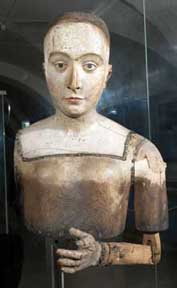



















Thank you for researching and posting such a fascinating story. I think it's Sarah's eyes that make her seem to real, and I'm quite sure most people would be spooked out by her effigy.